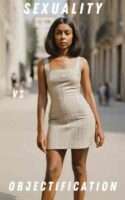Hey, let’s talk about a tricky line we’re all navigating: Walking the tightrope between embracing our sexuality and being sexualized? It’s tricky. Why? Because patriarchal norms – fuelled by everyone, yes, even women – often dictate how we show up in the world. Let’s dive into this battleground.
I recently stumbled upon a post by feminist author Farida D (@farida.d.author) on Instagram. She highlighted a stark contradiction, “Girls are taught that being sexual is shameful. Boys are taught that sexualising girls is normal. And then women learn that it’s normal to be sexualised by men. While men learn that it’s shameful for women to be sexual. And so women struggle to enjoy their bodies when they are expected to behave as objects. While men struggle to respect women’s bodies when they are expected to see them as objects.”
As women reclaim control over their bodies and sexuality, I believe that this holds importance in today’s times. Let’s begin by distinguishing between the concepts of sexuality and being sexualised.
When a woman embraces her sexuality, she embodies her unique self-expression and individuality. This liberation from patriarchal constraints allows women to express their true selves through various means, including their relationships, clothing choices, and behaviours.
UCT Psychology student Amanda (22) explained her understanding of sexuality, saying: “Perceptions of sexuality differ. I think being sexual can mean shaking your bums with your friends or wearing short clothes in your Instagram OOTD, which are both okay”.
On the other hand, when a woman is sexualised, she is solely viewed for her sexual appeal, while her self-expression is disregarded. Any other form of expression holds no significance; a sexualised woman is reduced to an object tailored to fit the patriarchal standards.
This is harmful as it perpetuates the notion that a sexual woman is always “asking for it,” regardless of her actions or behaviour. Viewing and treating women solely as sexual objects dangerously reinforces rape culture and victim-blaming.
“Dignified” women hide their sexuality and pleasure from public view, and while that’s acceptable, so is embracing one’s sexuality in all its forms. However, it becomes problematic when women who choose to express themselves openly are deliberately sexualised.
Take, for instance, Kim Kardashian’s nude photo on Twitter in 2016. At the time, I was 17 and viewed her actions as shameful. But why? The ensuing controversy prompted Kim to defend herself, stating that she felt empowered by her sexuality and did not intend to promote objectification.
UCT Master’s Student Jacky, 24, shared: “Being sexualised on social media robs you of your freedom of choice and control over your body. Strangers don’t have trust or consent of the person they are sexualising, and it’s so demeaning”.
It’s essential to reconsider the notion that while sharing intimate photos on social media may initially appear to celebrate one’s sexuality, the audience’s involvement – through sharing and comments, for instance – can ultimately lead to objectification.
Another example worth analysing is Nicki Minaj’s “Anaconda” music video, where she and other women celebrate their bodies by dancing erotically for themselves, without male presence. While Minaj twerks, it’s on her terms, aiming to inspire women to embrace their curves and pursue the same sexual freedom she exemplifies.
On this point, Data Analyst Asanda, 25, shares: “It has become more frequent for sexual artists to portray themselves in a new space of expression of distinctive sexual empowerment rather than portraying them as objects of a gaze to counter the sexualisation.”
Whether overtly sexual or not, objectifying women has far-reaching consequences, from erasing the erotic to subjecting women to intense surveillance and body policing.
We should be able to navigate the world comfortably, but cultures that reduce women to mere property continue to confine us.
What practical steps can young people take to shift the objectification of women towards a culture that respects female sexuality in all its forms?



